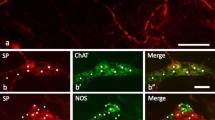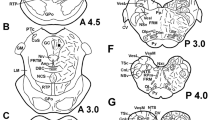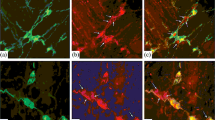Summary
The distribution and cellular localization of substance P in the chicken gut was studied by immunocytochemistry and immunochemistry. Substance P-containing nerve fibers are numerous in the gut wall. They occur in the smooth muscle layer as well as in the mucosa, where they are associated with blood vessels or surround the intestinal crypts. The fibers are particularly numerous in the myenteric and submucosal plexuses, where substance P-containing nerve-cell perikarya are also encountered. Substance P was found also in scattered endocrine cells of the small intestine, caeca and colon. Previously, bombesin-containing cells, which are numerous in the proventriculus, have been mistakenly identified as substance P cells due to crossreactivity of certain antisera against substance P. Immunochemistry revealed the highest concentration of substance P in the duodenum. The gel chromatographic behavior of chicken substance P differs slightly from that of synthetic bovine substance P, suggesting that chicken substance P differs structurally from mammalian substance P. Substance P-containing nerve fibers in the chicken gut develop slowly after hatching, apparently beginning in the duodenum; at approximately 20 weeks after hatching the distribution pattern is fully developed.
A functional investigation was performed on the isolated chicken caecum to clarify the role of substance P in the contractile behavior of smooth muscle. Substance P contracted the caecum over a wide dose range; the contractile response was greater in 20 week-old chickens than in 4 and 10 week-old animals. Electrical field stimulation caused a relaxation of the caecum and a contraction upon cessation of stimulation. Neither of these responses, both of which are neurally mediated, were inhibited by adrenergic and cholinergic blockade. It is conceivable that the contractile response following electrical stimulation is caused by substance P released from nerve fibers in the smooth muscle.
Similar content being viewed by others
References
Björklund A, Falck B, Owman Ch (1972) Fluorescence microscopic and microspectrofluorometric techniques for the cellular localization and characterization of biogenic monoamines. In: Berson SA (ed) Methods of investigative and diagnostic endocrinology, vol 1, Ral JE, Kopin IJ (eds) The thyroid and biogenic amines. North-Holland Publ Comp, Amsterdam, pp 318–368
Cleugh J, Gaddum JH, Holton P, Leach E (1961) Assay of substance P on the fowl rectal caecum. Br J Pharmacol 17:144–158
Coons AH, Leduc EG, Connolly JM (1955) Studies on antibody production. I. A method for the histochemical demonstration of specific antibody and its application to a study of the hyperimmune rabbit. J Exp Med 102:49–60
Costa M, Cuello AC, Furness JB, Franco R (1980) Distribution of enteric neurones showing immunoreactivity for substance P in the guinea-pig ileum. Neuroscience 5:323–331
Dockray GJ, Vaillant C, Walsh JH (1979) The neuronal origin of bombesin-like immunoreactivity in the rat gastrointestinal tract. Neuroscience 4:1561–1568
Erspamer V, Falconieri Erspamer G, Linari G (1977) Occurrence of tachykinins (physalaemin- or substance P-like peptides) in the amphibian skin and their actions on smooth muscle preparations. In: Euler US von, Pernow B (eds) Substance P. Raven Press, New York, pp 67–74
Erspamer V, Erspamer GF, Melchiorri P, Negri L (1979) Occurrence and polymorphism of bombesinlike peptides in the gastrointestinal tract of birds and mammals. Gut 20:1047–1056
Euler US von, Gaddum JH (1931) An unidentified depressor substance in certain tissue extracts. J Physiol (Lond) 72:74–87
Folkers K, Hörig J, Rosell S, Björkroth U (1981) Chemical design of antagonists of substance P. Acta Physiol Scand, in press
Franco R, Costa M, Furness JB (1979) Evidence that axons containing substance P in the guinea-pig ileum are of intrinsic origin. Naunyn-Schmied. Arch Pharmacol 307:57–63
Heitz Ph, Polak JM, Timson CM, Pearse AGE (1976) Enterochromaffin cells as the endocrine source of gastrointestinal substance P. Histochemistry 49:343–347
Hökfelt T, Johansson O, Kellerth J-O, Ljungdahl Å, Nilsson G, Nygårds A, Pernow B (1977) Immunohistochemical distribution of substance P. In: Euler US von, Pernow B (eds) Substance P. Raven Press, New York, pp 117–145
Kao CY (1966) Tetrodotoxin, saxitoxin and their significance in the study of excitation phenomena. Pharm Rev 18:997–1049
Lazarus LH, Linnoila RI, Hernandez O, Di Augustine RP (1980) A neuropeptide in mammalian tissues with physalaemin-like immunoreactivity. Nature 287:555–558
Malmfors G, Leander S, Brodin E, Håkanson R, Holrnin T, Sundler F (1980) Peptidergic neurones are intrinsic to the gut wall. An experimental study in the pig. Cell Tissue Res 214:225–238
McDonald TJ, Jörnvall H, Nilsson G, Vagne M, Ghatei M, Bloom SR, Mutt V (1979) Characterization of a gastrin releasing peptide from porcine non-antral gastric tissue. Biochem Biophys Res Commun 90:227–233
Nilsson G, Brodin E (1977) Tissue distribution of substance P-like immunoreactivity in dog, cat, rat and mouse. In: Euler US von, Pernow B (eds) Substance P. Raven Press, New York, pp 49–54
Nilsson G, Larsson L-I, Håkanson R, Brodin E, Pernow B, Sundler F (1975a) Localization of substance P-like immunoreactivity in the mouse gut. Histochemistry 43:97–99
Nilsson G, Pernow B, Fisher GH, Folkers K (1975b) Presence of substance P-like immunoreactivity in plasma from man and dog. Acta Physiol Scand 94:542–544
Nilsson G, Pernow B, Fisher GH, Folkers K (1977) Radioimmunological determination of substance P. In: Euler US von, Pernow B (eds) Substance P. Raven Press, New York, pp 41–48
Pearse AGE, Polak JM (1975) Immunocytochemical localization of substance P in mammalian intestine. Histochemistry 41:373–375
Pearse AGE, Polak JM, Adams C, Kendall PA (1974) Diethylpyrocarbonate, a vapour phase fixative for immunofluorescence studies on polypeptide hormones. Histochem J 6:347–352
Pernow B (1953) Studies on substance P: Purification, occurrence and biological actions. Acta Physiol Scand 29:(Suppl) 105
Polak JM, Bloom SR (1980) Neural and cellular origin of gastrointestinal hormonal peptides in health and disease. In: Jerzy Glass GB (ed) Gastrointestinal hormones. Raven Press, New York, pp 19–51
Schultzberg M, Dreyfus CF, Gershon MD, Hökfelt T, Elde RP, Nilsson G, Said S, Goldstein M (1978) VIP-, enkephalin-, substance P- and somatostatin-like immunoreactivity in neurons intrinsic to the intestines: immunochemical evidence from organotypic tissue cultures. Brain Res 155:239–248
Schultzberg M, Hökfelt T, Nilsson G, Terenius L, Rehfeld JF, Brown M, Elde R, Goldstein M, Said SI (1980) Distribution of peptide- and catecholamine-containing neurons in the gastro-intestinal tract of rat and guinea-pig: Immunohistochemical studies with antisera to substance P, vasoactive intestinal polypeptide, enkephalins, somatostatin, gastrin/cholecystokinin, neurotensin and dopamine-β-hydroxylase. Neuroscience 5:689–744
Sternberger LA (1974) Immunocytochemistry. Prentice-Hall Inc., New Jersey
Sundler F, Alumets J, Hökanson R (1977a) 5-Hydroxytryptamine-containing enterochromaffin cells: Storage site of substance P. Acta Physiol Scand (Suppl) 452:121–123
Sundler F, Håkanson R, Larsson L-I, Brodin E, Nilsson G (1977b) Substance P in the gut: An immunohistochemical and immunochemical study of distribution and development. In: Euler US von, Pernow B (eds) Substance P. Raven Press, New York, pp 59–65
Sundler F, Alumets J, Fahrenkrug J, Hökanson R, Schaffalitzky de Muckadell OB (1979) Cellular localization and ontogeny of immunoreactive vasoactive intestinal polypeptide (VIP) in the chicken gut. Cell Tissue Res 196:193–201
Timson CM, Polak JM, Wharton J, Ghatei MA, Bloom SR, Usellini L, Capella C, Solcia E, Brown MR, Pearse AGE (1979) Bombesin-like immunoreactivity in the avian gut and its localization to a distinct cell type. Histochemistry 61:213–221
Vaillant C, Dockray GJ, Walsh JH (1979) The avian proventriculus is an abundant source of endocrine cells with bombesin-like immunoreactivity. Histochemistry 64:307–314
Author information
Authors and Affiliations
Rights and permissions
About this article
Cite this article
Brodin, E., Alumets, J., Håkanson, R. et al. Immunoreactive substance P in the chicken gut: Distribution, development and possible functional significance. Cell Tissue Res. 216, 455–469 (1981). https://doi.org/10.1007/BF00238643
Accepted:
Issue Date:
DOI: https://doi.org/10.1007/BF00238643




